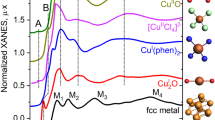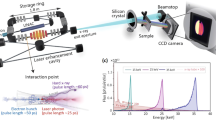Abstract
IN the issue of the Zeitschrift für Physik for July 2, 1924, Dr. Coster reports the existence of a white line on the long wave-length side of the absorption edge in the case of the higher valence forms of various elements. Evidence has been obtained in this laboratory that iodic acid and potassium permanganate, two of the substances for which he reports this line, are slowly reduced by X-rays. If this occurs in the absorbing screen, it seems reasonable to expect that the photographic plates will show not only the absorption edge of the original compound, but also that of the reduced portion. According to Lindh's results with phosphorus, sulphur, and chlorine, the absorption edge of the reduced form might be expected to fall on the long wave-length side of the main edge. It seems reasonable, therefore, to raise the question whether the white line Dr. Coster reports may not be the absorption edge of that part of the material in the absorbing screen reduced by the X-ray.
This is a preview of subscription content, access via your institution
Access options
Subscribe to this journal
Receive 51 print issues and online access
$199.00 per year
only $3.90 per issue
Buy this article
- Purchase on Springer Link
- Instant access to full article PDF
Prices may be subject to local taxes which are calculated during checkout
Similar content being viewed by others
Author information
Authors and Affiliations
Rights and permissions
About this article
Cite this article
CHAMBERLAIN, K. Fine Structure of X-Ray Absorption Edges. Nature 114, 500–501 (1924). https://doi.org/10.1038/114500b0
Issue Date:
DOI: https://doi.org/10.1038/114500b0
This article is cited by
-
Die physikalischen Grundlagen der chemischen Wirkungen des Lichts und der Röntgenstrahlen
Ergebnisse der Physiologie (1930)
Comments
By submitting a comment you agree to abide by our Terms and Community Guidelines. If you find something abusive or that does not comply with our terms or guidelines please flag it as inappropriate.



